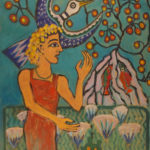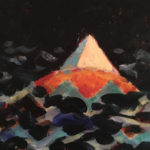There is one more episode to relate.
It is interesting to note that the version by Plutarch contains such different interpretations of the facts. This is why it is important to seek out the actual evidence. This evidence is called pharaonic evidence and is what the Ancient Egyptians themselves wrote on papyrus, stelae and walls.
In the Introduction to The Book of The Dead, Dr. Ogden Goulet says “It should be borne in mind that there often can be more than one interpretation, and we should beware of overconfidently imposing our conceptions upon Egyptian religion. “
And I would add, especially when there is not one single word in the hieroglyphics that means ‘religion’. Check out the dictionary….
REVENGE AND THE BATTLE FOR INHERITANCE
…the story continues….
But as Horus grew in this world the spirit of Osiris visited him often and taught him all that a great warrior should know – one who was to fight against Seth both in the body and in the spirit.

The battles that occur are many with a great variety of themes and a lot of trickery. At one point, Isis interferes with Horus preventing him from killing Seth and gets her head cut off. Thoth uses his magic to replace it.
Horus- wearing the dual crown of Upper and Lower Egypt
In the end, Horus loses an eye and Seth loses his testicles. There is even a story of a homosexual encounter. As was stated in the beginning, these stories are scattered about, some on walls, some on papyri. (As you might imagine, I haven’t been able to verify all of them.)
Horus gathered his forces and prepared to begin the war. And Re himself, the shining father of the gods, came to his aid in his own divine boat that sails across the heavens and through the dangers of the underworld.

Before they set sail Re drew Horus aside so as to gaze into his blue eyes: for whoever looks into them, of gods or men, sees the future reflected there. But Seth was watching; and he took upon himself the form of a black pig – black as the thunder-cloud, fierce to look at, with tusks to strike terror into the bravest heart.
Meanwhile Re said to Horus: “Let me gaze into your eyes, and see what is to come of this war.” He gazed into the eyes of Horus and their color was that of the Great Green Sea when the summer sky turns it to deepest blue.
While he gazed the black pig passed by and distracted his attention, so that he exclaimed: “Look at that! Never have I seen so huge and fierce a pig.”
And Horus looked; and he did not know that it was Seth, but thought it was a wild boar out of the thickets of the north, and he was not ready with a charm or a word of power to guard himself against the enemy.
Then Seth aimed a blow of fire at the eyes of Horus; and Horus shouted with the pain and was in a great rage. He knew now that it was Seth; but Seth had gone on the instant and could not be trapped.
Re caused Horus to be taken into a dark room, and it was not long before his eyes could see again as clearly as before. When he was recovered Re had returned to the sky; but Horus was filled with joy that he could see, once more, and as he set out up the Nile at the head of his army, the country on either side shared his joy and blossomed into spring.
There were many battles in that war, but the last and greatest was at Edfu, where the great temple of Horus stands to this day in memory of it. The forces of Seth and Horus drew near to one another among the islands and the rapids of the First Cataract of the Nile. Seth, in the form of a red hippopotamus of gigantic size, sprang up on the island of Elephantine and uttered a great curse against Horus and against Isis:
“Let there come a terrible raging tempest and a mighty flood against my enemies!” he cried, and his voice was like the thunder rolling across the heavens from the south to the north. At once the storm broke over the boats of Horus and his army; the wind roared and the water was heaped into great waves. But Horus held on his way, his own boat gleaming through the darkness, its prow shining like a ray of the sun.
Opposite Edfu, Seth turned and stood at bay, straddling the whole stream of the Nile, so huge a red hippopotamus was he. But Horus took upon himself the shape of a handsome young man, twelve feet in height. His hand held a harpoon thirty feet long with a blade six feet wide at its point of greatest width.

Seth opened his mighty jaws to destroy Horus and his followers when the storm should wreck their boats. But Horus cast his harpoon, and it struck deep into the head of the red hippopotamus, deep into his brain. And that one blow slew Seth the great wicked one, the enemy of Osiris and the gods – and the red hippopotamus sank dead beside the Nile at Edfu. The storm passed away, the flood sank and the sky was clear and blue once more. Then the people of Edfu came out to welcome Horus the avenger and lead him in triumph to the shrine over which the great temple now stands. And they sang the song of praise which the priests chanted ever afterwards when the yearly festival of Horus was held at Edfu:
“Rejoice, you who dwell in Edfu! Horus the great god, the lord of the sky, has slain the enemy of his father! Eat the flesh of the vanquished, drink the blood of the red hippopotamus, burn his bones with fire! Let him be cut in pieces, and the scraps be given to the cats, and the offal to the reptiles!
“Glory to Horus of the mighty blow, the brave one, the slayer, the wielder of the Harpoon, the only son of Osiris, Horus of Edfu, Horus the avenger!”
But when Horus passed from earth and reigned no more as the Pharaoh of Egypt, he appeared before the assembly of the gods, and Seth came also in the spirit, and contended in words for the rule of the world. But not even Thoth the wise could give judgment. And so it comes about that Horus and Seth still contend for the souls of men and for the rule of the world.
– NOTES –
So now we have met the major players (the neteru) in the Egyptian stories. There are over a thousand neteru but knowing them all is not necessary to follow their story. A few more will be introduced as the time comes.
The story of rebellion is an important theme in ancient Egypt. It’s quite clear that Horus represents goodness and Seth represents all that is evil. But that doesn’t interfere with cooperation between the two combatants. For instance, it is Seth who protects the Sun against his serpent enemy Apep on its journey through the duat.
We will refer to this story again.
I leave you with this one thought:
“Imagine a group of nomads, spears in hand discovering the Nile valley and saying “Ah, here is where we can build our model of the cosmos. Look, stone, we can build pyramids. And here, here is where we will carve our image of the Sphinx. We can do this; we have copper chisels.”
Keath Rycroft, the artist and author of this website



